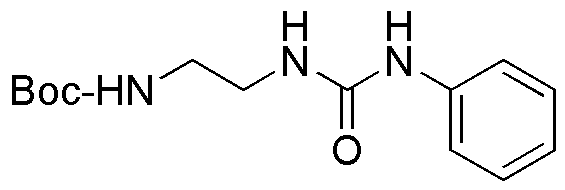Tert-Butyl 2-(3-Phenylureido)Ethylcarbamate is widely utilized in research focused on:
- Pharmaceutical Development: This compound serves as a key intermediate in the synthesis of various pharmaceuticals, particularly in the development of drugs targeting neurological disorders.
- Agricultural Chemicals: It is used in formulating herbicides and pesticides, enhancing the effectiveness of crop protection products while minimizing environmental impact.
- Biochemical Research: Researchers employ this compound in studies related to enzyme inhibition, providing insights into metabolic pathways and potential therapeutic targets.
- Polymer Chemistry: It acts as a building block in the synthesis of novel polymers, which can be tailored for specific applications in coatings and materials science.
- Diagnostic Reagents: This chemical is utilized in the development of diagnostic tests, improving the accuracy and reliability of disease detection methods.
General Information
Properties
Safety and Regulations
Applications
Tert-Butyl 2-(3-Phenylureido)Ethylcarbamate is widely utilized in research focused on:
- Pharmaceutical Development: This compound serves as a key intermediate in the synthesis of various pharmaceuticals, particularly in the development of drugs targeting neurological disorders.
- Agricultural Chemicals: It is used in formulating herbicides and pesticides, enhancing the effectiveness of crop protection products while minimizing environmental impact.
- Biochemical Research: Researchers employ this compound in studies related to enzyme inhibition, providing insights into metabolic pathways and potential therapeutic targets.
- Polymer Chemistry: It acts as a building block in the synthesis of novel polymers, which can be tailored for specific applications in coatings and materials science.
- Diagnostic Reagents: This chemical is utilized in the development of diagnostic tests, improving the accuracy and reliability of disease detection methods.
Documents
Safety Data Sheets (SDS)
The SDS provides comprehensive safety information on handling, storage, and disposal of the product.
Product Specification (PS)
The PS provides a comprehensive breakdown of the product’s properties, including chemical composition, physical state, purity, and storage requirements. It also details acceptable quality ranges and the product's intended applications.
Certificates of Analysis (COA)
Search for Certificates of Analysis (COA) by entering the products Lot Number. Lot and Batch Numbers can be found on a product’s label following the words ‘Lot’ or ‘Batch’.
Numéro de catalogue
Numéro de lot/série
Certificates Of Origin (COO)
This COO confirms the country where the product was manufactured, and also details the materials and components used in it and whether it is derived from natural, synthetic, or other specific sources. This certificate may be required for customs, trade, and regulatory compliance.
Numéro de catalogue
Numéro de lot/série
Safety Data Sheets (SDS)
The SDS provides comprehensive safety information on handling, storage, and disposal of the product.
DownloadProduct Specification (PS)
The PS provides a comprehensive breakdown of the product’s properties, including chemical composition, physical state, purity, and storage requirements. It also details acceptable quality ranges and the product's intended applications.
DownloadCertificates of Analysis (COA)
Search for Certificates of Analysis (COA) by entering the products Lot Number. Lot and Batch Numbers can be found on a product’s label following the words ‘Lot’ or ‘Batch’.
Numéro de catalogue
Numéro de lot/série
Certificates Of Origin (COO)
This COO confirms the country where the product was manufactured, and also details the materials and components used in it and whether it is derived from natural, synthetic, or other specific sources. This certificate may be required for customs, trade, and regulatory compliance.

